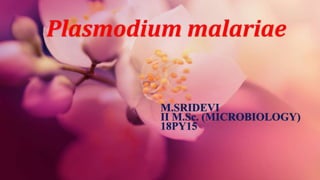Plasmodium malariae
•Download as PPTX, PDF•
6 likes•2,080 views
Plasmodium malariae is a protozoan parasite that causes malaria in humans. It is transmitted via the bites of infected female Anopheles mosquitoes. Malaria infects hundreds of millions of people annually and kills over a million people, mostly young children. P. malariae has a multi-stage lifecycle involving human and mosquito hosts. Diagnosis involves microscopic examination of blood smears to detect the parasite. Common symptoms include fever, chills, and flu-like illness. Treatment options include drugs like chloroquine, atovaquone/proguanil, and prevention involves mosquito repellents and bed nets.
Report
Share
Report
Share

Recommended
More Related Content
What's hot
What's hot (20)
Similar to Plasmodium malariae
Similar to Plasmodium malariae (20)
malaria-141112210953-conversion-gate02 (1) (1).pptx

malaria-141112210953-conversion-gate02 (1) (1).pptx
More from sridevi244
More from sridevi244 (8)
Recently uploaded
Recently uploaded (20)
Topography and sediments of the floor of the Bay of Bengal

Topography and sediments of the floor of the Bay of Bengal
Jet reorientation in central galaxies of clusters and groups: insights from V...

Jet reorientation in central galaxies of clusters and groups: insights from V...
The ASGCT Annual Meeting was packed with exciting progress in the field advan...

The ASGCT Annual Meeting was packed with exciting progress in the field advan...
GBSN - Microbiology (Lab 1) Microbiology Lab Safety Procedures

GBSN - Microbiology (Lab 1) Microbiology Lab Safety Procedures
Extensive Pollution of Uranus and Neptune’s Atmospheres by Upsweep of Icy Mat...

Extensive Pollution of Uranus and Neptune’s Atmospheres by Upsweep of Icy Mat...
insect taxonomy importance systematics and classification

insect taxonomy importance systematics and classification
word2vec, node2vec, graph2vec, X2vec: Towards a Theory of Vector Embeddings o...

word2vec, node2vec, graph2vec, X2vec: Towards a Theory of Vector Embeddings o...
A Giant Impact Origin for the First Subduction on Earth

A Giant Impact Origin for the First Subduction on Earth
Constraints on Neutrino Natal Kicks from Black-Hole Binary VFTS 243

Constraints on Neutrino Natal Kicks from Black-Hole Binary VFTS 243
Plasmodium malariae
- 1. Plasmodium malariae M.SRIDEVI II M.Sc. (MICROBIOLOGY) 18PY15
- 2. Classification • Domain: Eukaryote • Kingdom: Protista • Phylum: Apicomplexa • Class: Aconoidasida • Order: Haemosporida • Family: Plasmodiidae • Genus: Plasmodium • Species: malariae
- 3. Introduction • Malaria is caused by species of Plasmodium. • Discovered by Charles Louis Alphonse Laveran (1880) • 500 million people will be infected with malaria worldwide • widely found in sub-Saharan Africa, southeast Asia, and islands in the western Pacific
- 4. • The genus Plasmodium contains over 200 species at least 11 species infect humans • Most important are: Plasmodium falciparum Plasmodium malariae Plasmodium ovale Plasmodium vivax Plasmodium knowlesi • Plasmodium parasites are highly specific with female Anopheles mosquitoes
- 5. EPIDEMOLOGY • Around 300-500 million clinical cases of malaria are reported every year, of which more than a million die of severe and complicated cases of malaria. • Malaria is known to kill one child every 30 sec, 3000 children per day under the age of 5 years.
- 7. Vector • Female mosquitos of genus Anopheles are primary hosts and transmission vectors. • There are approximately 460 recognized species • Over 100 can transmit human malaria • Only 30–40 commonly transmit parasites of the genus Plasmodium • Anopheles gambiae is one of the best known which transmits Plasmodium falciparum
- 8. Fig: Female Anopheles Mosquito
- 9. • Only female mosquitoes feed on blood while the males feed on plant nectar and do not transmit the disease. • The females of Anopheles genus prefer to feed at night • They start searching for a meal at dusk and continue throughout the night until they take a meal
- 10. MOSQUITOES AND MALARIA The spread of malaria depends on the life cycle of the mosquito. •Adult mosquitoes lay their eggs on water. •The eggs hatch to become larvae and then pupae, before turning into adults. •Adult females mosquitoes only live 2 to 4 weeks. •So you can reduce malaria by attacking any of these four stages of the mosquito
- 11. CHARACTERISTIC OF LIFE CYCLE Intermediate host : human Final host : mosquito Infective stage : sporozoite Infective way : mosquito bite skin of human Parasitic position : liver and red blood cells Transmitted stage : gametocytes Schizogonic cycle in red cells : 48 hrs.
- 12. Life cycle
- 14. INCUBATION PERIOD • Following the infective bite by the Anopheles mosquito a period of time (the "incubation period") goes by before the first symptoms appear. • The incubation period in most cases varies from 7 to 30 days. • The shorter periods are observed most frequently with P. falciparum and the longer ones with P. malariae.
- 15. Symptom • fever • flu-like illness • shaking chills • Headache • muscle aches • tiredness • Nausea, • vomiting, • diarrhea • anemia & jaundice
- 16. LABORATORY DIAGNOSIS • Laboratory diagnosis of malaria is confirmed by the demonstration of malarial parasites in the blood film under microscopic examination. • Thin film • Thick film • Thick smears have more quantity of blood in a smaller area, so that the parasites are concentrated in this area, hence chances of detection of malaria parasite are more in a thick smear • Thin smears are less sensitive for detection of malaria parasites but better for species identification
- 17. Fig: Thin smear Fig: Thick smear
- 21. • HALOFANTRINE • MALARONE • ATOVAQUONE/PROGUANIL • TAFENOQUINE • QUININE • CHLOROQUINE TREATMENT
- 22. Chemoprophylaxis
- 23. Prevention • Use mosquito repellants. • Wear long pants and long sleeves. • Use window screens • Use bed nets.